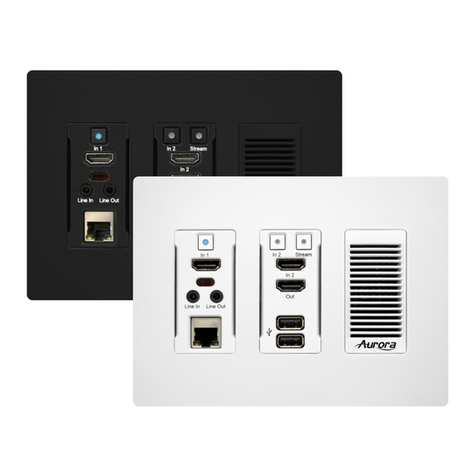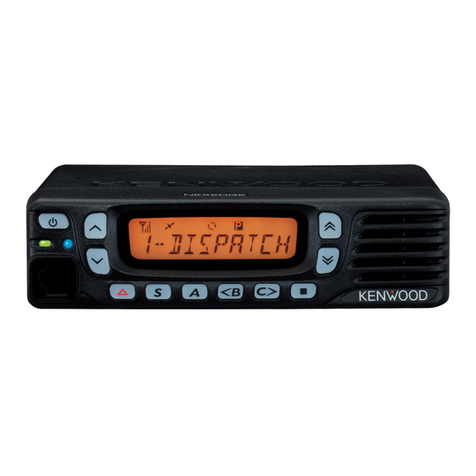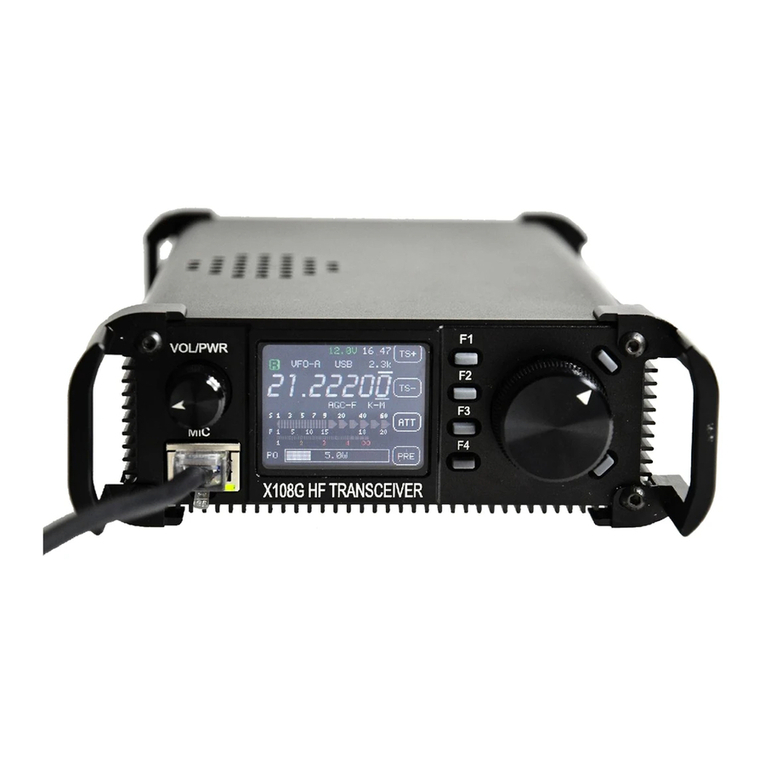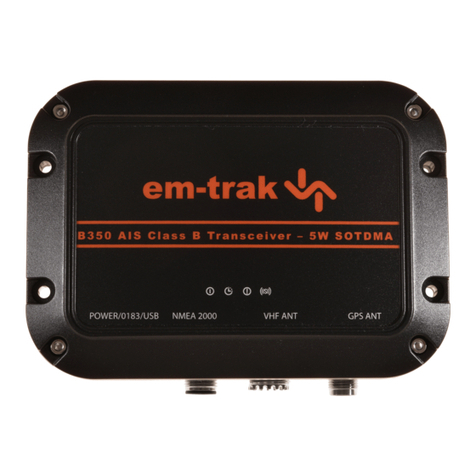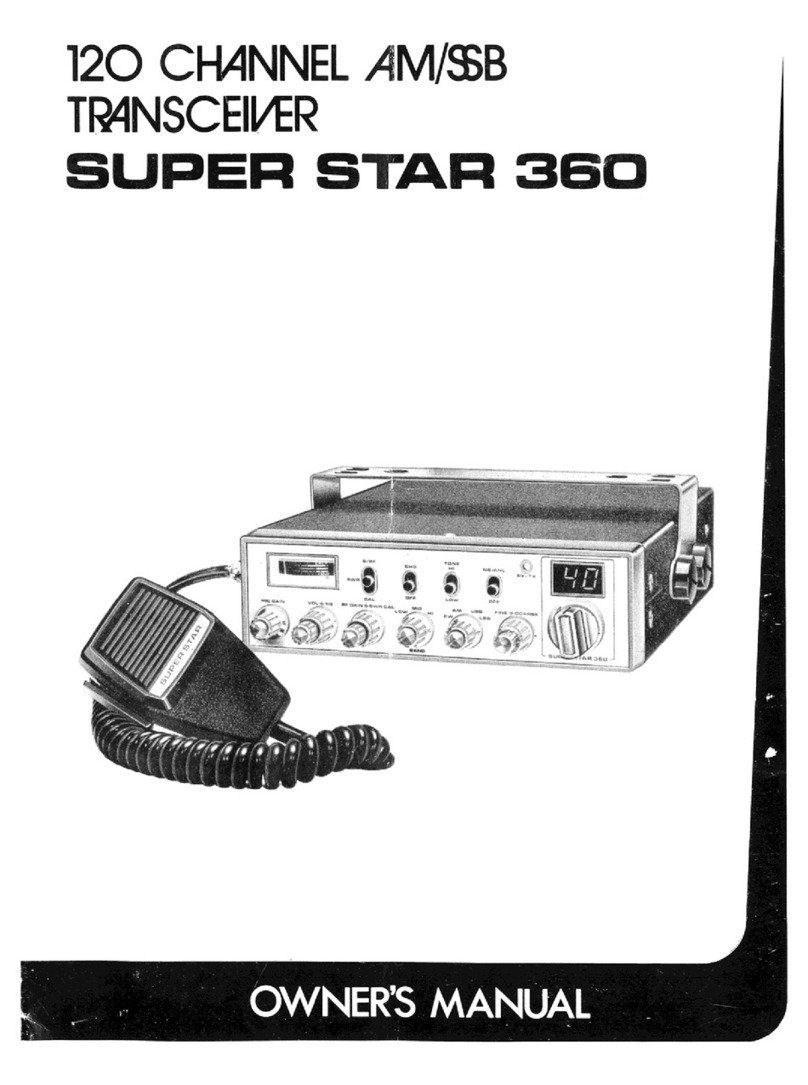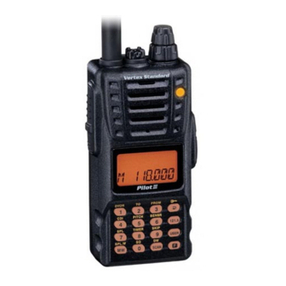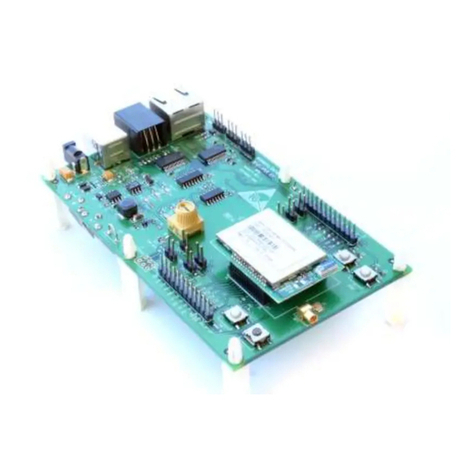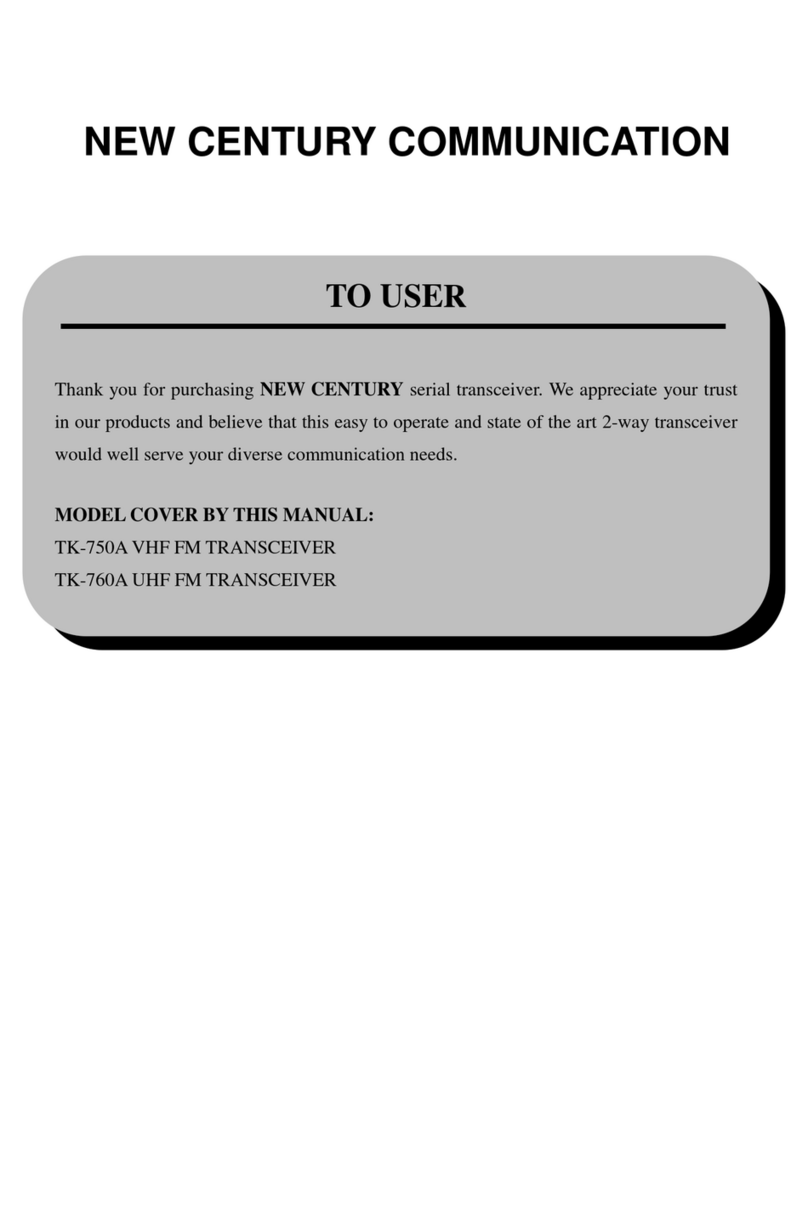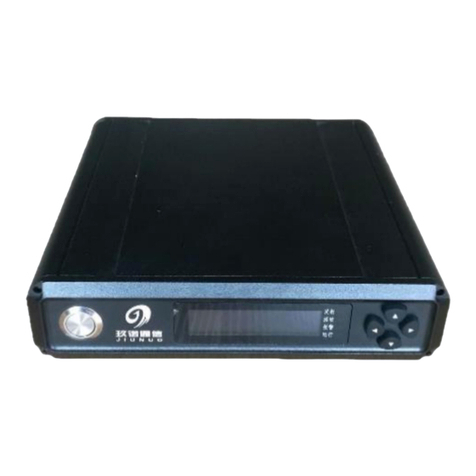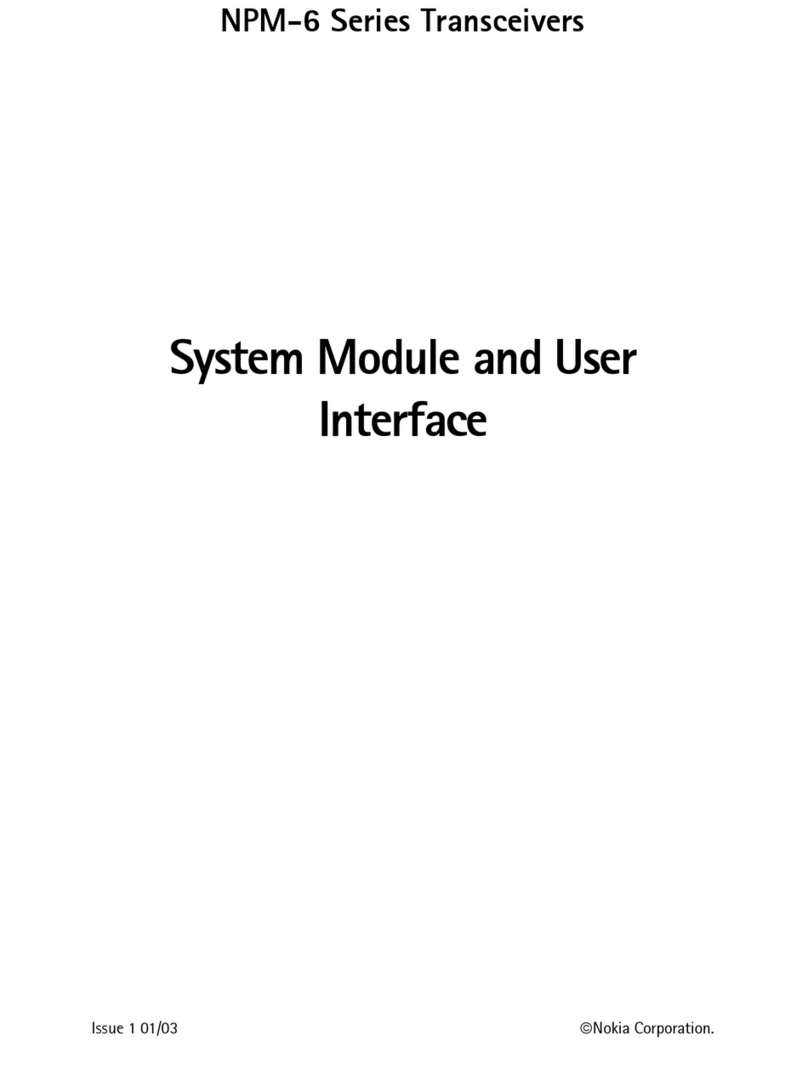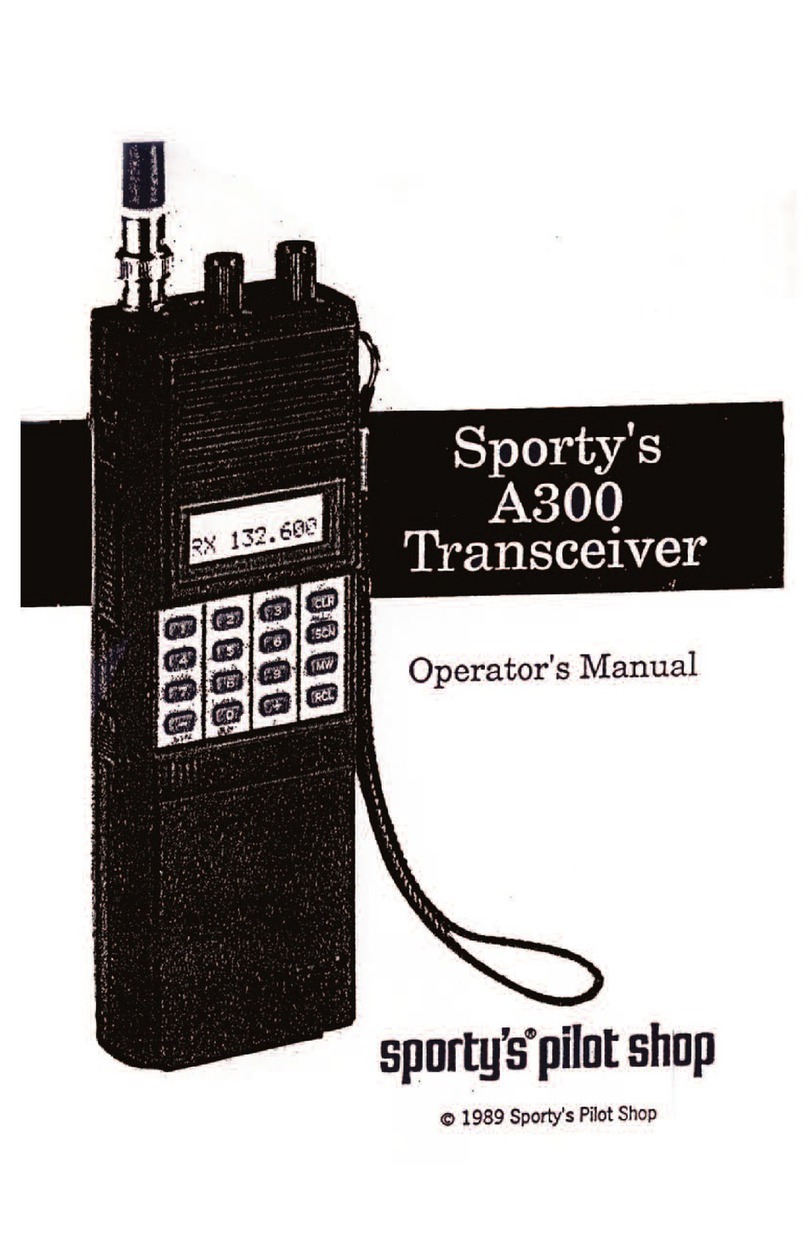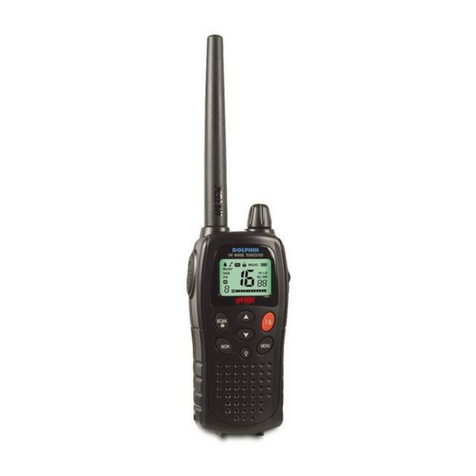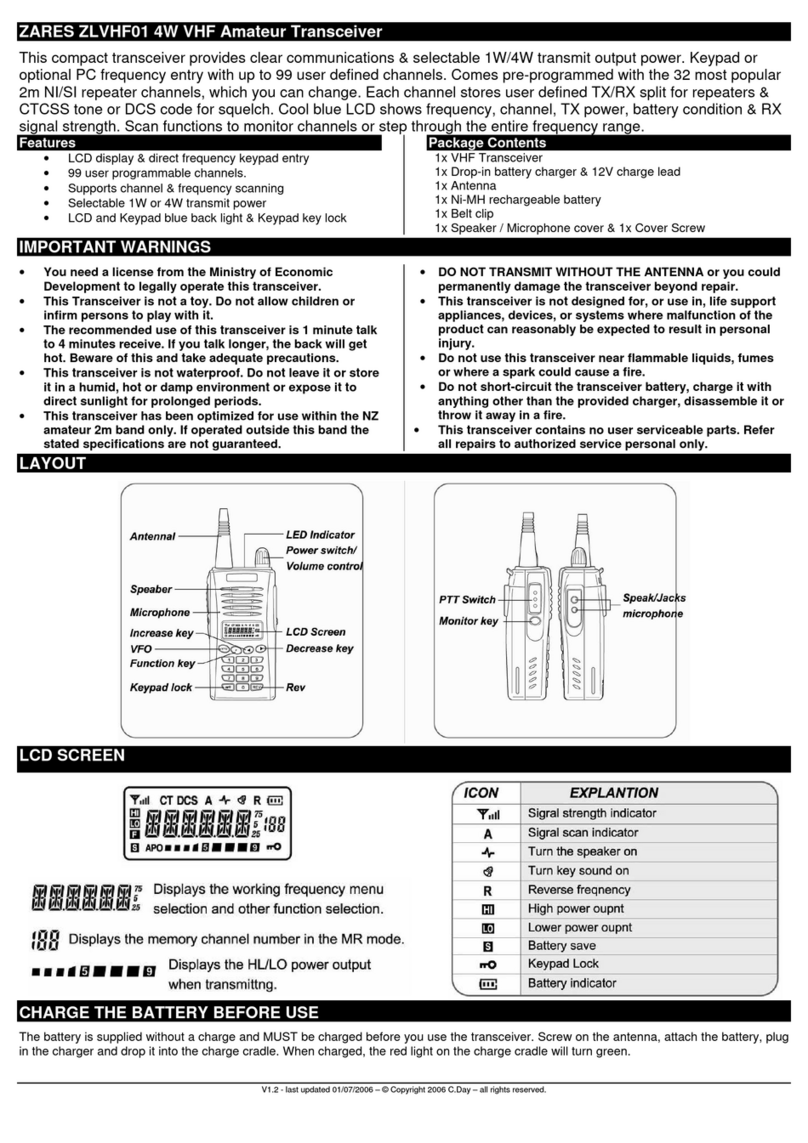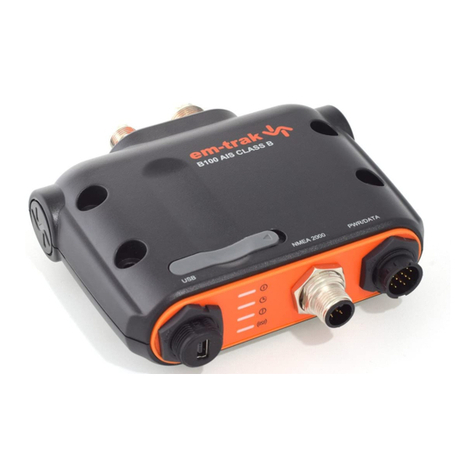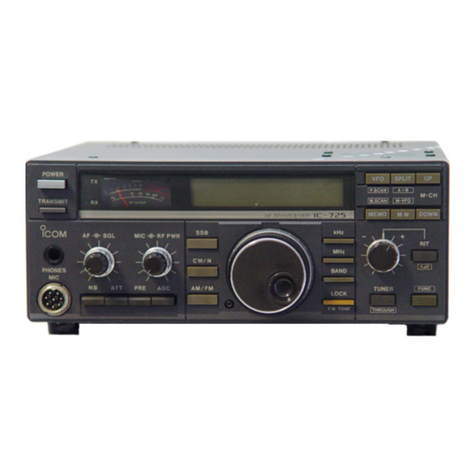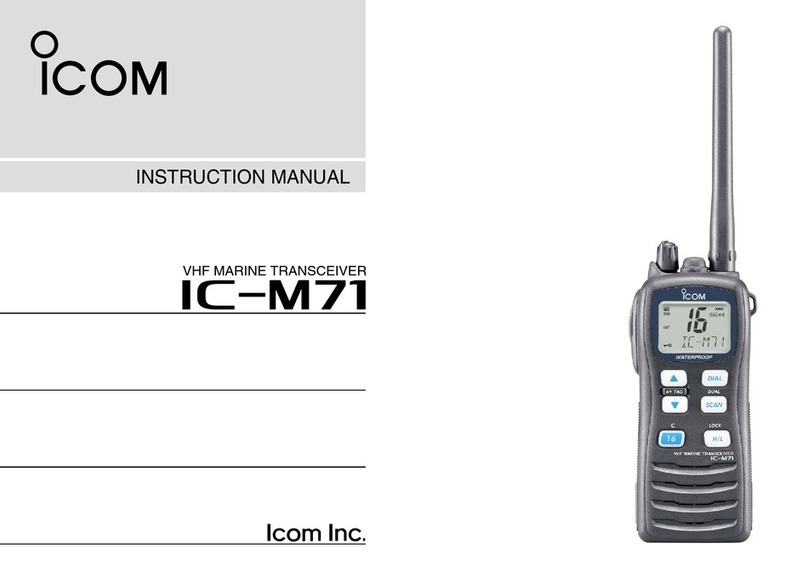General Dynamics URC-200 (V2) User manual

URC-200 (V2) LOS TRANSCEIVER
OPERATION AND MAINTENANCE MANUAL
8220 East Roosevelt Street, M/D R3163
Scottsdale, AZ 85257
Contract Number: N65236-09-D-3532
Document No: 99-P42304K
File Name: URC200V2_99-P42304K _RevD.doc
Revision: D
Revision Date: March 2011


GeneralDynamics C4 Systems URC-200 (V2)
For customer support, service and technical questions within the hours of 7:30
am – 4:30 pm MST, Mon-Fri, please call the following toll free phone number:
In the U.S.: 1-800-424-0052
E-mail: customerserv[email protected]om
For customer support, service and technical questions outside of these hours,
please call the following toll free phone numbers:
In the U.S.: 1-877-449-0600
Outside the U.S.: Toll free AT&T Direct 877-466-9467 (Dial AT&T Direct access
number for the country where you are located. When prompted, enter 877-466-9467).
E-mail: customerserv[email protected]om
For additional product information, please contact:
GENERAL DYNAMICS
C4 Systems
8220 E. Roosevelt Street, M/D R3163
Scottsdale, AZ 85257
Email: info@gdc4s.com
Web site: http://www.gdc4s.com
COPYRIGHT 2009-2011 GENERAL DYNAMICS. All trademarks indicated as such
herein are trademarks of General Dynamics®Reg. U.S. P.T.O. All other product or
service names are the property of their respective owners.
General Dynamics reserves the right to make changes in its products and specifications
at any time and without notice.
General Dynamics C4 Systems, Inc.
EXPORT CONTROL WARNING:
Do not disclose or provide this document or item (including its contents) to non-U.S.
Citizens or non-U.S. Permanent Residents, or transmit this document or item (including
its contents) outside the United States without the written permission of General
Dynamics and required U.S. Government export approvals.


GeneralDynamics C4 Systems URC-200 (V2)
i
TABLE OF CONTENTS
SAFETY ............................................................................................................................................. v
1.0 INTRODUCTION ................................................................................................................... 1
1.1 Purpose and Functions ......................................................................................................... 1
1.2 Features ................................................................................................................................ 2
1.3 Performance Characteristics................................................................................................. 2
1.3.1 Options.......................................................................................................................... 5
1.3.2 Description of the URC-200 (V2) Transceiver............................................................. 6
1.4 Power Requirements .......................................................................................................... 11
1.5 Environmental Operation and Storage............................................................................... 11
1.6 List of Items Furnished ...................................................................................................... 12
1.7 List of Items Not Furnished ............................................................................................... 12
1.8 Tools and Test Equipment.................................................................................................. 15
1.9 Shipping and Handling Precautions................................................................................... 15
2.0 PREPARATION FOR USE AND INSTALLATION........................................................... 17
2.1 Unpacking .......................................................................................................................... 17
2.2 Installation.......................................................................................................................... 17
2.2.1 Attaching the Handset................................................................................................. 19
2.2.2 Attaching the Antenna ................................................................................................ 19
2.2.3 Removing the Antenna ............................................................................................... 20
2.2.4 Transceiver Placement and Antenna Sighting............................................................ 20
3.0 PRINCIPLES OF OPERATION ........................................................................................... 21
3.1 Transceiver Functional Description........................................................................................ 21
3.2 Receiver Functional Description........................................................................................ 24
3.2.1 Receiver Input Signals..................................................................................................... 25
3.2.2 Receiver Output Signals ............................................................................................. 26
3.3 Transmitter Functional Description ................................................................................... 27
3.4 30-90 MHz Option Functional Description ....................................................................... 28
3.4.1 30-90 MHz Receiver Functional Description............................................................. 30
3.4.2 30-90 MHz Transmitter Functional Description......................................................... 31
4.0 OPERATING INSTRUCTIONS........................................................................................... 33
4.1 Transceiver Placement and Antenna Sighting ................................................................... 33
4.2 Controls, Indicators And Connectors................................................................................. 33
4.3 Keypad and Display Functions .......................................................................................... 35
4.4 Normal Operating Mode Configuration Procedures.......................................................... 36
4.4.1 Turning on the Unit ........................................................................................................ 36
4.4.2 Cancellation of Presets ................................................................................................... 37
4.4.3 Front Panel Illumination................................................................................................. 37
4.4.4 Select Speaker ON/OFF ................................................................................................. 37
4.4.5 Select Meter Mode.......................................................................................................... 37
4.4.6 Setting Preset Channels .................................................................................................. 38
4.4.7 Selecting Special Modes................................................................................................. 41
4.4.8 Voice (PT) Operation ..................................................................................................... 44
4.5 URC-200 (V2) EEPROM Limitations............................................................................... 44
4.5.1 Select Scan Channels...................................................................................................... 45
4.5.2 Cancellation of Presets ................................................................................................... 45

GeneralDynamics C4 Systems URC-200 (V2)
ii
4.5.3 Select Preset Channels.................................................................................................... 45
4.5.4 Storing Presets................................................................................................................ 45
4.5.5 Alignment Command Limitations.................................................................................. 45
4.6 Remote Operation .............................................................................................................. 45
4.6.1 Remote Control Interconnect.......................................................................................... 46
4.6.2 Data Rates and Logic Levels.......................................................................................... 46
4.6.3 Data Exchange Protocol ................................................................................................. 47
4.6.4 Remote Control Codes.................................................................................................... 48
4.7 Options............................................................................................................................... 64
4.7.1 EBN-30, 30 TO 90 MHz Option.................................................................................... 64
4.7.2 EBN-400, 400 TO 420 MHZ Option.............................................................................. 67
4.7.3 ECS-8, 8.33 kHz Option................................................................................................ 69
Aviation mode........................................................................................................................... 70
5.0 MAINTENANCE .................................................................................................................. 73
5.1 Cleaning ............................................................................................................................. 73
5.2 Performance Verification................................................................................................... 73
5.3 Manual System Test........................................................................................................... 73
5.3.1 Test Equipment Required............................................................................................... 73
5.3.2 Receiver Tests................................................................................................................. 75
5.3.3 Transmitter Tests............................................................................................................ 98
5.3.4 Power Supply Voltages ................................................................................................ 117
5.4 Inspection ......................................................................................................................... 119
5.5 Troubleshooting ............................................................................................................... 119
5.6 Shipping ........................................................................................................................... 120
5.7 Storage.............................................................................................................................. 120
5.8 Electrical Interfaces.......................................................................................................... 121
6.0 PARTS LIST........................................................................................................................ 127
7.0 URC-200 (V2) SYSTEMS................................................................................................... 129
7.1 Rack Mounted Base System............................................................................................. 129
7.1.1 Rack Mounted Base System Description of Operation................................................ 129
7.1.2 Rack Mounted Base System Installation...................................................................... 131
7.1.3 Rack Mounted Base System Operation........................................................................ 132
7.1.4 Rack Mounted Base System Troubleshooting.............................................................. 133
7.1.5 Rack Mounted System Remove and Replace Procedures............................................ 133
7.2 Portable Backpack System............................................................................................... 136
7.2.1 Backpack System Description of Operation................................................................. 137
7.2.2 Backpack System Installation....................................................................................... 139
7.2.3 Backpack System Operation......................................................................................... 139
APPENDIX A–URC-200 (V2) CRYSTAL WARP ADJUSTMENT ........................................................ 141

GeneralDynamics C4 Systems URC-200 (V2)
iii
LIST OF FIGURES
Figure 1 - URC-200 (V2) Transceiver Radio..................................................................................... 6
Figure 2 - Outline Dimensions.......................................................................................................... 10
Figure 3 - Battery Case ..................................................................................................................... 17
Figure 4 - Battery Pack Installation.................................................................................................. 18
Figure 5 - Transceiver Simplified Functional Block Diagram ......................................................... 23
Figure 6 - Receiver Functional Block Diagram................................................................................ 25
Figure 7 - Receiver Output Signal Diagram..................................................................................... 26
Figure 8 - Transmitter Functional Block Diagram ........................................................................... 27
Figure 9 - 30-90 MHz Transceiver Simplified Functional Block Diagram...................................... 29
Figure 10 - 30-90 Receiver Functional Block Diagram.................................................................... 31
Figure 11 - Front and Rear Panel Controls, Indicators and Connectors........................................... 34
Figure 12 - Key-pad and Display Functions..................................................................................... 35
Figure 13 - Remote-Control Unit...................................................................................................... 45
Figure 14 - HyperTerminal Configuration........................................................................................ 47
Figure 15 - 30 to 90 MHz Option Front Panel.................................................................................. 67
Figure 16 - Receiver Test Equipment Setup..................................................................................... 76
Figure 17 - Transmitter Test Setup................................................................................................. 100
Figure 18 - Breakout Box Schematic.............................................................................................. 119
Figure 19 - URC-200 (V2) Interfaces............................................................................................. 126
Figure 20 - Rack Mount System Components................................................................................ 129
Figure 21 - Rack Mount System Block Diagram with AC Power Supply ..................................... 130
Figure 22 – Rack Mounted Installed System.................................................................................. 134
Figure 23 - Rack Mount Tray Hardware......................................................................................... 134
Figure 24 - Backpack System Components.................................................................................... 137
Figure 25 - Backpack System Block Diagram................................................................................ 138
LIST OF TABLES
Table 1 - Performance Characteristics................................................................................................ 2
Table 2 - Battery Types....................................................................................................................... 7
Table 3 - Equipment Weight and Dimensions.................................................................................... 9
Table 4 - Environmental Characteristics........................................................................................... 11
Table 5 - List of Items Furnished...................................................................................................... 12
Table 6 - URC-200 (V2) Operational Frequency-Based Dependencies........................................... 22
Table 7 - Front Panel Controls, Indicators and Connector and Rear Panel Connectors................... 34
Table 8 - Remote Control Interconnect ............................................................................................ 46
Table 9 - Remote Responses............................................................................................................. 48
Table 10 - URC-200 (V2) Operational Frequency-Based Dependencies......................................... 49
Table 11 - Remote Transceiver Operation Commands..................................................................... 50
Table 12 - Transceiver Customizing Codes...................................................................................... 57
Table 13 - Transceiver Status Inquiry Commands ........................................................................... 59
Table 14 - 30 to 90 MHz Specifications........................................................................................... 65
Table 15 - LVHF Band Required Equipment................................................................................... 66
Table 16 - 400 to 420 MHz Specifications....................................................................................... 68

GeneralDynamics C4 Systems URC-200 (V2)
iv
Table 17 - 400 to 420 MHz Band Required Equipment................................................................... 68
Table 18 - Aviation Mode Frequency Chart..................................................................................... 71
Table 19 - Test Equipment Required................................................................................................ 74
Table 20 - Alternate Test Equipment................................................................................................ 74
Table 21 - FM Frequency Presets..................................................................................................... 77
Table 22 - AM Frequency Presets .................................................................................................... 82
Table 23 - Internal Voltages ........................................................................................................... 117
Table 24 - Error Messages.............................................................................................................. 120
Table 25 - Power Connector J1 (CA110821-1) Pin Characteristics............................................... 121
Table 26 - Power Connector J5 (CA110821-1) Pin Characteristics............................................... 122
Table 27 - Handset Connector J4 (GC283F-1-050) Pin Characteristics......................................... 122
Table 28 - Remote Connector J2 (MS3114E16-26S) Pin Characteristics...................................... 123
Table 29 - URC-200 (V2) Connector Identification....................................................................... 125
Table 30 - URC-200 (V2) Parts...................................................................................................... 127

GeneralDynamics C4 Systems URC-200 (V2)
v
SAFETY
CAUTION
To comply with RF exposure requirements, a minimum separation distance of
20 cm (7.9 inches) is required between the antenna and all persons while the
transceiver is transmitting. ManPack (backpack) and hand-carry users should
not exceed 50% duty cycle, as this approaches RF hazard limits and reduces
battery life.
CAUTION
Several conditions must be observed when using the UVU-100 LOS antenna
mounted on the transceiver's front panel, as serious damage to the transceiver
may result if high RF power is allowed to leak into the interior of the transceiver
directly from the antenna.
1. Transmit ONLY with the cover of the transceiver securely fastened in place.
2. Use ONLY vendor supplied power supplies, such as the RF shielded battery
case (UBC-100) or power supply (UAC-100).
3. Use ONLY tempest approved shielded cables with the REMOTE connector.
CAUTION
When performing a self-calibration, the radio antenna port(s) must be attached
directly to a good 50 ohm load(s). BNC type loads are acceptable. Use of a
Type N to BNC adapter is recommended on the 30-90MHz antenna port (if
present). The use of attenuators (instead of 50-ohm loads) or cables between
load and antenna port can lead to calibration errors if there are strong RF
signals present. Failure to follow the above procedure can result in severely
degraded performance.
CAUTION
DO NOT attempt to change the operating frequency while the transmitter is
keyed on. Although the radio set will not be damaged, the radiated frequency
will be uncontrolled during tuning and can cause unnecessary interference to
other radio systems.

GeneralDynamics C4 Systems URC-200 (V2)
vi
CAUTION
DO NOT install the LOS antenna on the transceiver during testing in the
transmit mode with (1) the cover removed or (2) the transceiver powered from
an external power supply via test leads that are unshielded. RF from the
antenna can radiate into the transceiver, circumvent the protection loops, and
cause severe damage to the transmitter circuits.
WARNING
DO NOT THROW BATTERIES IN THE TRASH
Dispose of all used batteries in accordance with all manufacturer, Federal, State
and local laws and regulations.
Improper handling, reverse-current operation or high environmental
temperatures may cause internally generated heat, fire, or toxic materials and
gasses to be released from the battery.
The following precautions must be strictly observed to prevent injury to
personnel or damage to equipment:
•DO NOT heat, incinerate, crush, puncture, disassemble or mutilate the
batteries.
•DO NOT recharge primary (Non- rechargeable) batteries.
•DO NOT store in equipment during periods of non-use for more than 30
days.
•DO follow all safety instructions that come with the batteries or printed on
them.
•TURN OFF the equipment immediately if you (1) detect that the battery
compartment is becoming unduly hot, (2) hear battery cells venting (hissing), or
(3) smell irritating sulfur dioxide gas. Remove the battery only after it is cool
(after 30 to 60 minutes), and dispose of it by following approved procedures.

GeneralDynamics C4 Systems URC-200 (V2)
1
1.0 INTRODUCTION
This manual provides operation and maintenance instructions for the URC-200 (V2) Radio Set, part
number 01-P36744M003, shown in Figure 1. The radio set is a lightweight VHF/UHF transceiver
providing AM/FM transmission and reception of non-secure voice or data in the frequency bands
used in maritime, land, mobile and tactical line-of sight communications, as well as military and
civilian air traffic control operations. Secure communications are achieved with an appropriate
external encryption device and with the transceiver in the data (Cipher Text) mode.
NOTE
The URC-200 (V2) is FCC certified in the 115 – 149.995 (AM) and 115 –
173.995 (FM) bands.
1. The URC-200 (V2) transceiver is to be tuned only to those frequencies
that the transceiver user, by law, is permitted to use.
2. Operation and tuning the transceiver should be restricted to those users
who are knowledgeable about which frequencies are authorized for use.
3. Transceiver operation on unauthorized frequencies is a violation of the
law.
4. The capabilities of this transceiver allow users the freedom for authorized
personnel to easily tune the transceiver. This allows the transceiver to work
with other communication systems within the band, if the transceiver's tuned
frequencies are permitted by regulation.
1.1 Purpose and Functions
The URC-200 (V2) VHF/UHF Transceiver is a lightweight, tactical, Line-Of-Sight (LOS)
transceiver that provides AM and FM communication of nonsecure voice or data. It is suitable for
ManPack, vehicular, or fixed station applications. The transceiver is compatible with other AM or
FM transceivers operating in the same VHF and UHF frequency ranges.
•In the AM mode the VHF frequency range is 115 to 149.9950 MHz
•In the FM mode the VHF frequency range is 115 to 173.9950 MHz
•In both the AM and FM modes the UHF frequency range is 225 to 399.9950 MHz
The transceiver has standard tuning increments of 25 kHz, 12.5 kHz and 5 kHz with a channel
spacing as detailed in Table 1.The transceiver is capable of transmitting and receiving analog Plain
Text (PT) voice and digital Cipher Text (CT) voice or data. Achieve secure communications with
an appropriate external encryption device and the transceiver in the data (CT) mode. The URC-200
(V2) operates in most weather conditions and can be remote controlled.

GeneralDynamics C4 Systems URC-200 (V2)
2
Three options are available. Refer to Paragraph 4.7 for a full description of each option.
•A 30-90 MHz FM Low VHF option.
•An extended 400-420 MHz FM UHF option.
•An 8.33 kHz tuning increment and channel spacing option.
1.2 Features
The features offered by the transceiver include the following:
•Microprocessor controlled transceiver
•COMSEC compatibility. Achieve secure communications with an appropriate
external encryption device and with the transceiver in the data [Cipher Text (CT)]
mode
•Multi-band capability including civilian and military frequencies
•Easy access front panel controls
•Built-in speaker
•RS-232 remote control for all programmable functions
•Backlit display and keypad
•Ten preset memory channels with fully programmable frequencies, including
transmit/receive offsets and AM/FM selection
•Self-calibrating varactor-tuned receiver front-end
1.3 Performance Characteristics
Table 1 identifies the URC-200 (V2) performance characteristics (without 30-90 or 400 MHz
options). Table 1 - Performance Characteristics
Standard Test Conditions: 28VDC Input, +25
°
C
Characteristics Specifications
General
Frequency Range
VHF - (FM) 115 to 173.995 MHz (AM) 115 to 149.995 MHz.
UHF - (FM) 225 to 399.995 MHz (AM) 225 to 399.995 MHz.
Tuning Increments
25 kHz 12.5 kHz and 5 kHz (8.33 KHz Optional)
Channel Spacing
25 kHz (8.33 KHz Optional)
Stability
±
1 ppm
Preset Channels
10 transmit and 10 receive preset channels.
Modulation
AM or FM
Power
Operating Voltage
+22 to +34 VDC
Current
3.5 Amps Maximum

GeneralDynamics C4 Systems URC-200 (V2)
3
Table 1 – Performance Characteristics (Continued)
Standard Test Conditions: 28VDC Input, +25
°
C
Characteristics Specifications
Estimated Battery
Life (2 Batteries)
Hours, based on 9:1 ratio receive to transmit.
BA-5390/U
30
BA-5590B/U
23
BB-390A/U
11
BB-590/U
7
BB-2590/U
19
Operating Modes
Plain Text (PT)
AM or FM
Cipher Text (CT)
AM or FM
T-R
Relay mode, each of 10 preset channels may have separate receive and
transmit frequencies.
Beacon
Transmit an emergency audio sweep tone on any selected frequency.
Scan
Scan up to 10 channels.
Bandwidth
IF Selectivity
PT - ±9.5 kHz, 6 dB down
CT -
±
15 kHz, 6 dB down
Audio Response
PT - 300 to 3000 Hz. (+2, -4 dB)
CT - 30 Hz to 10.24 kHz. (+2, -4 dB)
Receiver Characteristics
Sensitivity (10 dB
SINAD)
AM-CT
≤-105 dBm (1.3µV), 16 kb/sec with 70% modulation
AM-PT
≤
-103.5 dBm (1.5
µ
V), 1 kHz modulation at 30%
FM-CT
≤-107 dBm (1.0µV), 16 kb/sec with ±5.6 kHz deviation
FM-PT
≤
-114 dBm (0.4
µ
V), 1 kHz modulation with
±
6.5 kHz deviation
Input Impedance
50Ωnominal
RF Signal Level
at the Antenna Port
FM - No Signal to +25 dBm No signal to 315 mW (typical)
AM - No Signal to 0 dBm No signal to 1.0 mW (typical)
FM or AM - +27 dBm (500 mW) maximum for short durations without
damage.
Image Response
80 dB (typical)
Spurious Response
80 dB (typical)
Squelch
Manual adjust, Carrier-to-noise ratio squelch, changing to carrier-level
squelch at stronger signal levels.
Squelch Range
-110 dBm (0.7µV) to -80 dBm (22.3µV) nominal.
Distortion
AM - 10% Max., RF = -33dBm (5 mV), 1 kHz @ 85% AM Modulation
FM - 10% Max., RF = -33dBm (5 mV), 1 kHz @ ±6.5 kHz Modulation
Adjacent Channel
Rejection
25 kHz: 35dB typical
8.33 kHz: 45dB typical (ECS-8 option only.)

GeneralDynamics C4 Systems URC-200 (V2)
4
Transmitter Characteristics
High Power
Output Mode Tolerance Expressed in
Watts Avg. Expressed in
dBm Avg. Expressed
in Watts
CW
Expressed in
dBm CW
AM (at 80%
AM PT ±5%)
Maximum (+2
dBm)
15.85 Watts
42 dBm
12.01
Watts
40.8 dBm
Typical
10 Watts
40 dBm
7.58 Watts
38.8 dBm
Minimum (-2
dBm)
6.31 Watts
38 dBm
4.78 Watts 36.8 dBm
Low Power
Output Mode Tolerance Expressed in
Watts Avg. Expressed in
dBm Avg. Expressed
in Watts
CW
Expressed in
dBm CW
AM (at 80%
AM PT ±5%)
Maximum (+2
dBm)
7.94 Watts
39 dBm
6.02 Watts 37.8 dBm
Typical
5 Watts
37 dBm
3.79 Watts
35.8 dBm
Minimum (-2
dBm)
3.16 Watts
35 dBm
2.39 Watts 33.8 dBm
High Power
Output Mode Tolerance Expressed in Watts Expressed in
dBm
FM
Maximum (+2 dBm)
15.85 Watts
42 dBm
Typical
10 Watts
40 dBm
Minimum (-2 dBm)
6.31 Watts
38 dBm
Medium Power
Output Mode Tolerance Expressed in Watts Expressed in
dBm
FM
Maximum (+2 dBm)
7.94 Watts
39 dBm
Typical
5 Watts
37 dBm
Minimum (-2 dBm)
3.16 Watts
35 dBm
Low Power
Output Mode Tolerance Expressed in Watts Expressed in
dBm
FM
Nominal
0.1 Watts or 100 mW
20 dBm
Modulation
AM (PT)
60% to 90% at 1 kHz. : 15% Max. @ 80% AM
AM (CT)
70% nominal at 8 kHz. : Distortion 15% Max. @ 70% AM
FM (PT)
VHF
±
3.3 kHz at 1 kHz. : Distortion 10% Max.
UHF
±6.5 kHz at 1 kHz. : Distortion 10% Max.

GeneralDynamics C4 Systems URC-200 (V2)
5
Transmitter Characteristics (Cont.)
Modulation
(Cont.)
FM (CT)
VHF
±5.0 kHz at 1 kHz.
UHF
±
5.6 kHz at 1 kHz.
Spurious
Outputs
>=70 dB below CW carrier (typical)
Harmonic
Outputs
>=53 dB below CW carrier
Output
Impedance
50Ωnominal
Protection
No damage from open or short circuits at the antenna port.
Gradual transmit power reduction for high VSWR loads.
Transmit Duty
Cycle when in
the Hi Power
Output Mode
(10 W)
25 degrees C: continuous
55 degrees C: 9:1 receive to transmit duty cycle
Adjacent
Channel Power
25 kHz: 50 dB typical
8.33 kHz 40 dB typical (ECS-8 option only.)
1.3.1 Options
Three options are available for purchase to extend the URC-200 (V2) frequency range or change
the tuning increments or channel spacing. They are the 30-90 MHz, 400-420 MHz, and ECS-8,
8.33 kHz options. See Paragraph 4.7 for a detailed description of all options.
1.3.1.1 EBN-30, 30-90 MHz Option
Part Number 01-P37200N001. This option adds frequency range of 30-90 MHz to the URC-200
(V2). This option is for FM only in both receive and transmit modes. Plain or cipher text types of
signals may be used. See Paragraph 4.7.1 for a detailed description of this option.
1.3.1.2 EBN-400, 400-420 MHz Option
Part Number 01-P39234N001. This option extends the UHF frequency range of the URC-200 (V2)
to 420 MHz. In 400-420 MHz region this option is for FM only in both receive and transmit modes.
Both plain text and cipher text signals may be used in 400 to 420 MHz frequency range. See
Paragraph 4.7.2 for a detailed description of this option.
1.3.1.3 ECS-8, 8.33 kHz Option
Part Number 01-P42311K001. This option allows 8.33 kHz tuning in the VHF/UHF bands, and
user selectable 8.33 kHz receive channel spacing in the 117.9750 to 136.9750 MHz band when in
AM PT mode. See Paragraph 4.7.3 for a detailed description of this option.

GeneralDynamics C4 Systems URC-200 (V2)
6
It also allows the operator to place the radio into Aviation Mode, which restricts the operating
frequency range from 117.9750 to 136.9750 MHz, with tuning increments of 25 and 8.33 kHz. A
channel spacing of 25 or 8.33 kHz (receive only) is assigned automatically by channel entry. The
URC-200 aviation mode channel entry is based on ICAO Annex 10 to the Convention on
International Civil Aviation, Volume V. Refer to Table 18, Aviation Mode Frequency Chart.
Aviation Mode also restricts modulation to AM, and allows PT only, disabling the CT feature of
the radio.
1.3.2 Description of the URC-200 (V2) Transceiver
The basic URC-200 (V2) Transceiver system consists of an antenna, battery box, transceiver and
handset, as illustrated in Figure 1. See Table 5 for a list of items furnished.
Figure 1 - URC-200 (V2) Transceiver Radio
Handset
Transceiver
Battery Box
Antenna

GeneralDynamics C4 Systems URC-200 (V2)
7
1.3.2.1 Transceiver - URC-200 (V2)
The transceiver is contained in cast-aluminum housing with all operating controls and connectors
located on the front panel. The battery connectors, for two batteries, are located on the rear panel.
The front panel components are protected by handles on the sides, and an extension on the top
cover protects the volume and squelch controls.
1.3.2.2 Antenna - UVU-100
CAUTION
To comply with RF exposure requirements, a minimum separation distance of
20 cm (7.9 inches) is required between the antenna and all persons while the
transceiver is transmitting. ManPack (backpack) and hand-carry users should
not exceed 50% duty cycle, as this approaches RF hazard limits and reduces
battery life.
The antenna is a 12-inch long, broadband, VHF/UHF vertically polarized antenna that is attached to
the front panel antenna connector. The antenna connector is a BNC type connector, surrounded by
a threaded sleeve. The antenna is screwed onto this sleeve.
1.3.2.3 Battery Case - UBC-100
The battery case holds two batteries. When replacing batteries, always use two of the same part
number. When replacing non-rechargeable batteries, always replace both. Refer to Table 2 for
compatible battery types, part numbers, and reference documents.
Table 2 - Battery Types
Part Number
Composition
Type
Reference
BA-5390/U
Lithium Manganese
Dioxide
Non-rechargeable
MIL-PRF-49471
BA-5590B/U
Lithium Sulfur
Dioxide
Non-rechargeable
MIL-PRF-49471
BB-390A/U
Nickel Metal Hydride
Rechargeable
MIL-PRF-32052
BB-590/U
Nickel Cadmium
Rechargeable
MIL-PRF-32052
BB-2590/U
Lithium Ion
Rechargeable
MIL-PRF-32052

GeneralDynamics C4 Systems URC-200 (V2)
8
WARNING
DO NOT THROW BATTERIES IN THE TRASH
Dispose of all used batteries in accordance with all manufacturer, Federal, State
and local laws and regulations.
Improper handling, reverse-current operation or high environmental
temperatures may cause internally generated heat, fire, or toxic materials and
gasses to be released from the battery.
The following precautions must be strictly observed to prevent injury to
personnel or damage to equipment:
•DO NOT heat, incinerate, crush, puncture, disassemble or mutilate the
batteries.
•DO NOT recharge primary (Non- rechargeable) batteries.
•DO NOT store in equipment during periods of non-use for more than 30
days.
•DO follow all safety instructions that come with the batteries or printed on
them.
•TURN OFF the equipment immediately if you (1) detect that the battery
compartment is becoming unduly hot, (2) hear battery cells venting (hissing), or
(3) smell irritating sulfur dioxide gas. Remove the battery only after it is cool
(after 30 to 60 minutes), and dispose of it by following approved procedures.
Quick release latches enable the battery case to be securely attached to the unit for operation. When
the battery case is attached to the unit, the battery case is watertight. The case contains a vent to
permit venting of battery gasses.
1.3.2.4 Handset - H-189/GR
The handset contains a microphone and receiver for transmitting and receiving audio signals. A
retractable cord with a 5-pin connector attaches to the transceiver front panel. A push-to-talk switch
is located in the handset handle.
The URC-200 (V2) outline dimensions are shown in Figure 2. The equipment weight and
dimensions are shown in Table 3.

GeneralDynamics C4 Systems URC-200 (V2)
9
Table 3 - Equipment Weight and Dimensions
Characteristics
Specification
Transceiver
Height
3.13 inches
Width
10.8 inches
Depth
9.75 inches (including handles)
Weight (approximate)
9.2 pounds (10.4 pounds with 30-90 MHz option)
Battery Case
Height
3.13 inches
Width
10.80 inches
Depth
5.20 inches
Weight (approximate)
1.1 pounds without batteries
6.9 lbs with two BA-5390/U batteries
5.5 lbs with two BA-5590B/U batteries
9.1 lbs with two BB-390A/U batteries
6.9 lbs with two BB-590/U batteries
7.4 lbs with two BB-2590/U batteries

GeneralDynamics C4 Systems URC-200 (V2)
10
Figure 2 - Outline Dimensions
Table of contents

